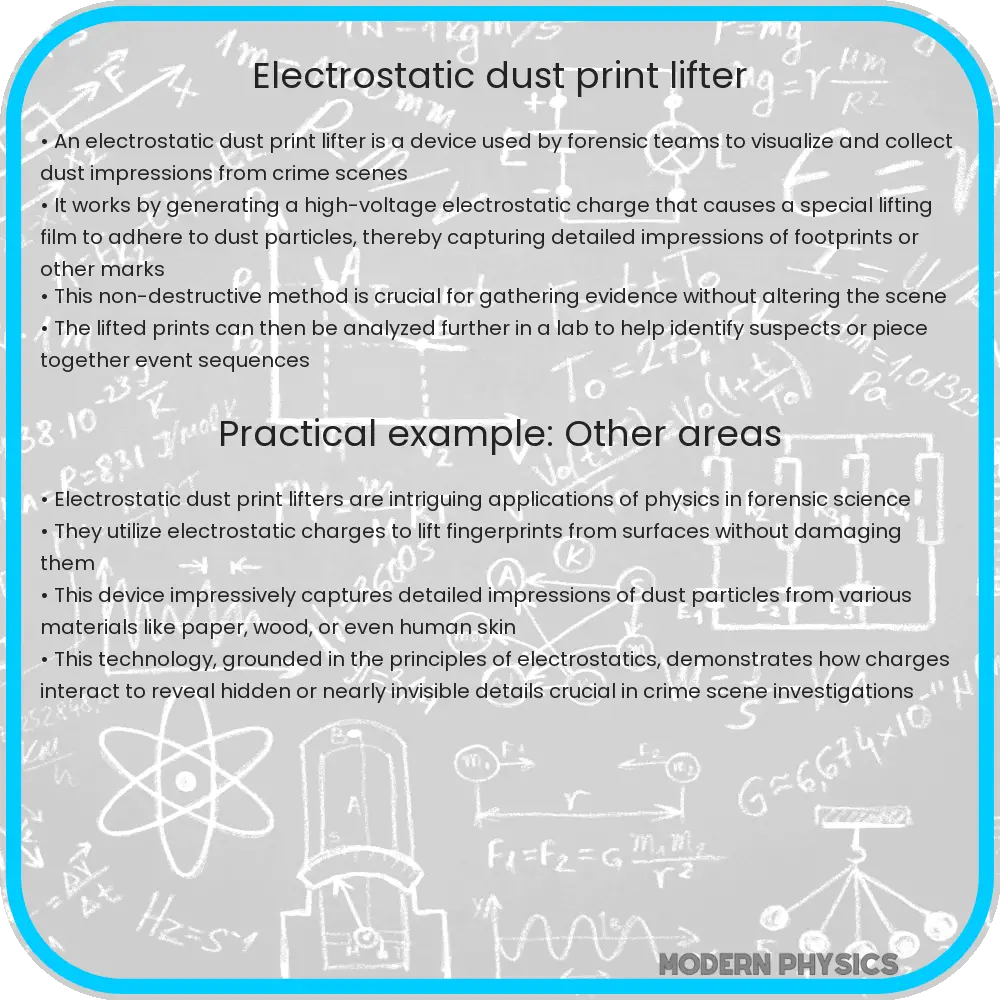Explore the Electrostatic Dust Print Lifter’s role in forensics, its operation, advantages, and future developments in crime scene analysis.

Understanding the Electrostatic Dust Print Lifter in Forensic Science
The Electrostatic Dust Print Lifter (EDPL) is an innovative tool in the field of crime scene investigation, particularly in the collection and preservation of dust impressions. Often overlooked, dust impressions can be crucial in forensic analysis, providing valuable information about the suspects or the sequence of events at a crime scene.
How the Electrostatic Dust Print Lifter Works
The EDPL operates on the principle of electrostatic charge. It uses a high-voltage power source to create an electrostatic field. This field charges a special lifting film, which is then carefully applied over the dust impression. The charged film attracts the dust particles, effectively lifting the print off the surface without disturbing its original state.
Advantages in Forensic Investigations
The EDPL offers several benefits in forensic investigations:
- Non-destructive Technique: It allows for the lifting of prints without altering or damaging them, which is crucial for maintaining the integrity of evidence.
- High Resolution: The lifted prints are often of high resolution, enabling detailed analysis and comparison.
- Versatile on Various Surfaces: This tool is effective on a wide range of surfaces, including floors, doors, and even textured or dusty surfaces.
Applications in Crime Scene Investigation
The EDPL is particularly useful in burglary cases, where intruders often leave footprints or tool marks in dust. The lifted prints can be compared with the suspects’ shoes or tools to establish a connection. Additionally, the EDPL is valuable in accident reconstruction and in cases involving movement through less frequented areas of a crime scene.
Challenges and Considerations
While the EDPL is a powerful tool, its effectiveness can be influenced by environmental factors such as humidity and the type of dust. Operators must be trained to use the device properly to avoid compromising the evidence. Furthermore, the interpretation of lifted prints requires expertise in forensic analysis.
In summary, the Electrostatic Dust Print Lifter is a significant advancement in forensic science, offering a non-invasive and effective method for collecting dust impressions at crime scenes. Its application, however, requires careful handling and expert analysis to ensure the integrity and usefulness of the evidence collected.
Technical Aspects and Limitations of the EDPL
The effectiveness of the Electrostatic Dust Print Lifter largely depends on the technical proficiency of the user and the environmental conditions. One key aspect is the control of the electrostatic charge, which must be carefully adjusted to ensure that the dust particles adhere to the lifting film without causing any distortion. Additionally, factors like the age of the dust print and the surface texture can influence the quality of the lifted impression. Users must also be aware of potential limitations in different environmental settings, such as high humidity, which can affect the electrostatic properties.
Integrating EDPL with Other Forensic Methods
To maximize its effectiveness, the EDPL is often used in conjunction with other forensic techniques. For instance, once a print is lifted, it can be further analyzed using various methods such as chemical analysis or comparison with known prints in databases. This multi-faceted approach allows for a more comprehensive analysis of the evidence, increasing the chances of accurately reconstructing events or identifying suspects.
Training and Expertise in EDPL Usage
Proper training in the use of the EDPL is crucial for forensic professionals. This includes understanding the principles of electrostatics, the handling of the equipment, and the interpretation of lifted prints. Continuous training and updates on the latest advancements in the field are essential for maintaining the proficiency of forensic experts in using this technology.
Future Developments and Innovations
As forensic science evolves, there is potential for further enhancements in EDPL technology. These advancements may include improvements in the sensitivity of the equipment, adaptability to a wider range of environmental conditions, and integration with digital technologies for faster and more accurate analysis. Ongoing research and development in this area promise to make the EDPL an even more indispensable tool in crime scene investigation.
Conclusion
The Electrostatic Dust Print Lifter represents a significant leap forward in forensic science, offering a sophisticated yet non-invasive method for collecting crucial evidence from crime scenes. Its ability to lift high-resolution prints from a variety of surfaces makes it an invaluable tool in the investigator’s arsenal. However, its effectiveness hinges on proper usage, environmental conditions, and subsequent analytical methods. As technology advances, the EDPL is likely to become even more efficient and integral to forensic investigations, aiding in the pursuit of justice and the unraveling of complex criminal cases.
